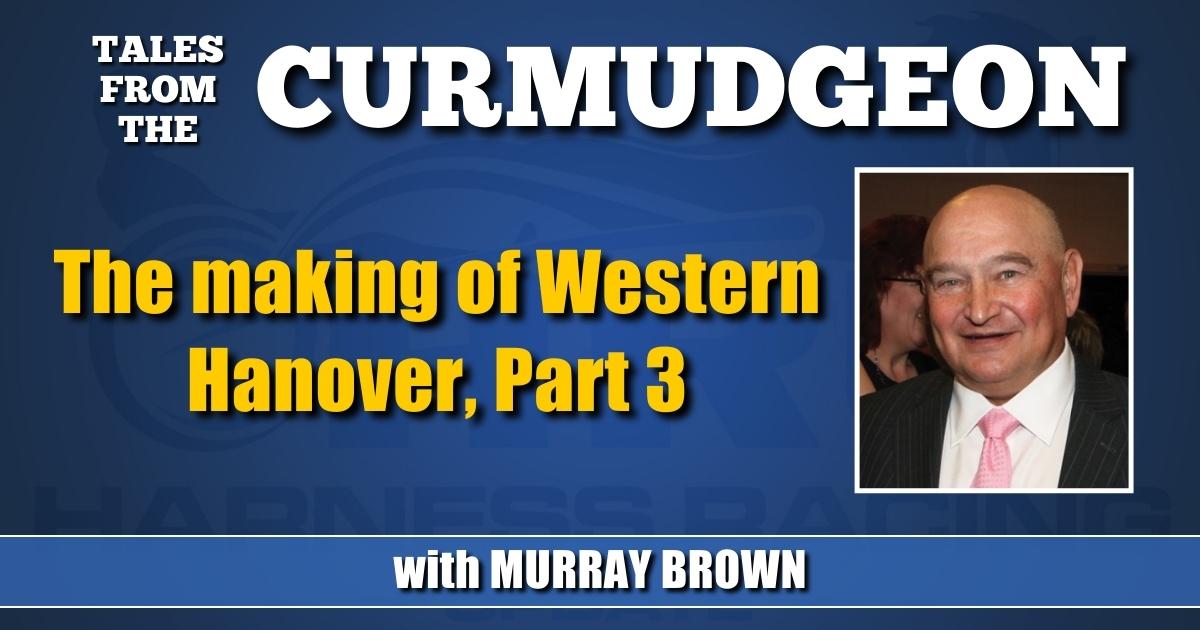The making of Western Hanover, Part 3
by Murray Brown
Part 1 is here.
Part 2 is here.
George Segal had a favorite word in describing the stud career of Western Hanover. That word was the Yiddish term “beshairt” which when translated would mean “meant to be.”
There were so many variables which went with the successful stud career of the son of No Nukes. The first of those was him ending up at Hanover Shoe Farms.
Hanover had entered into a verbal agreement with the Chasanoff Brothers — who together with Marty Granoff, owned another top No Nukes son, Die Laughing — to stand their horse at Hanover.
Hollywood producer Samuel Goldwyn is credited with saying “A verbal contract isn’t worth the paper it’s written on.” Thus it was with the agreement between the Chasanoffs and Hanover. They had a verbal agreement. Then at the last minute, the Chasanoffs came up with a clause with which the folks at Hanover could not live. That deal blew up.
If the Die Laughing deal had gone through there would be no way that Hanover would have been interested in standing Western Hanover. It also would have been unlikely that Segal would have been interested in standing Western Hanover alongside another son of No Nukes.
As fate would have it, Die Laughing was doomed to a stud career of mediocrity, while Western Hanover would become one of the very best of all pacing stallions.
The Die Laughing deal had initially left the folks at Hanover with a bitter taste in their mouths. That bitter taste was to turn to one of pure ecstasy when the exceptional success of Western Hanover, combined with the failure of Die Laughing, was attained. Those are the travails involved in breeding horses.
Western Hanover began his stud career at Hanover with some, but not much syndicate backing. Although one might say that having Brittany, Hanover and All American behind a horse would constitute a good beginning for any horse beginning his stud career. However, those three breeders were not the only ones who had faith in Western. There were others, mostly of the mom-and-pop variety, who were willing to send their mares to him, not only in his first two seasons at stud when most horses will draw the best and most mares they are ever likely to receive, but he also received more mares in books three and four than in one and two: a major rarity with almost all stallions.
In comparison, Artsplace started his stud career at the same year as Western Hanover. In years one and two he received 191 and 189. In years three and four, his books dropped somewhat to 150 and 162. In Western’s first two years, his books numbered 176 and 154. However, in years three and four they increased to 175 and 192.
Why was this, one might ask? To this observer the answer was twofold.
The first was the horse’s stud fee. At $4,000, the fee was an absolute bargain. It was almost as though Segal and the folks at Hanover had priced the horse at a fee well below market value. The only other horse that I would consider to have been an equal or perhaps even bigger bargain was Albatross who began at a fee of $5,000.
In both cases, it was as great a piece of marketing as I have observed in 66 years in the business. When one starts a horse in the stud, one generally does not make a whole lot of money in stud fees when the horse is starting out. It’s after he attains success, when the real money is to be made. Of course, not all stallions become successful. The majority do not. But if you own a top horse, believe in his future and want to give him as good a start as you can, the best way to start him off is at a reasonable stud fee. There is more money to be made beyond than there is at the start.
The second reason why Western Hanover was able to garner more mares in years three and four was due to the horse himself and the looks of his foals from his first two crops. They were absolutely stunning. With very few exceptions, he sired more, nice looking, correct individuals than this scribe has ever seen by any other horse. A significant number of them had what I would describe as “That Look” or as our thoroughbred brethren might say “The look of Eagles.” They not only looked like speed, they would soon prove that they possessed it.
Before I go any further, I need to relate a story about Western’s first crop. They looked good. They sold well, but not great. Artsplace’s first crop was also out that year. They sold much better as they were certainly expected to. Artsplace had been a marvelous racehorse. He was coming off a Horse of the Year season when he was undefeated. He was owned by a strong syndicate whose members sent many of their top mares to him.
Western got mares from Brittany, Hanover and All American: most of the mares he received were what I would describe as decent for the time. Although some like Rich N Elegant were to become great in part because they were bred to Western Hanover.
Fast forward to the Spring of 1996. The first crops by Artsplace and Western Hanover were in training. A decent number of them were in Florida. I received a call from horse agent Charley Karp. He had been in Florida for a good part of the winter. As usually is my wont, I asked him about 2-year-olds in training.
“The Artsplaces are great,” Karp said. “The trainers all love them. The Western Hanovers are terrible. Every trainer who I spoke with that has any, hates them. Tell Jimmy Simpson that the smartest thing he can do is make a gelding out of Western Hanover.”
Karp was half right. Artsplace certainly became a great stallion.
Right from the get-go, Western gave indications that he was going to be a force with which to be reckoned.
His first crop included the immortal Western Dreamer ($1,812,176), another millionaire in Rambaran ($1,121,332) and Stampede Hanover ($550,432).
His second crop blew the roof off with his most important horse, Western Ideal ($1,455,422), Metro winner Rustler Hanover ($971,638), Take Down The Flag ($864,720) and Take Flight ($602,443).
The third crop of $500,000 plus winners were all Hanover-breds: The Panderosa ($1,452,418), the first sub 1.50 2-year-old Badlands Hanover ($754,772) and Union Guy ($517,586).
The fourth crop included Tyberwood ($1,351,952), Ain’t No Stopn Him ($779,338), Ruffed Up ($650,089) and Richess Hanover ($557,537).
After crop four, the public knew what kind of sire he was, perhaps most importantly most breeders, especially those who had initially turned down the chance to invest in Western, had changed their minds. It cost them a great deal to do so. They were now anxious to invest in this great young stallion: albeit at several times the price at which they could have from the start.
Western Hanover was the sire of 26 millionaires, the winners of $156,421,710, including Won The West ($3,939,836), Clear Vision ($2,733,796), Well Said ($2,569,342) and We Will See ($2,549,409).
The story on Western Hanover is not quite done yet. There are still a few of his mares still producing foals. He is already recognized as not only a great sire, but as a great broodmare sire. That is a given though. There are very few sure things when it comes to breeding horses. One of them certainly is that all great sires are also great broodmare sires. Western Hanover’s daughters have already produced the winners of $293,555,901.

















